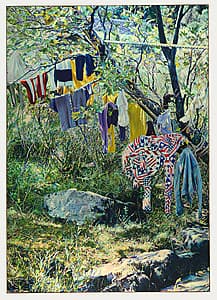

Franz Gertsch
Learn moreSaint Guilhem 1972
Purchased 1973
More detail | PermalinkIn Saint Guilhem 1972 Franz Gertsch approaches his subject with a precision typical of his photorealist contemporaries in the United States and elsewhere. The painting, while depicting a light-filled landscape of the Mediterranean region, portrays objects and imagery that suggest broader, even internationalist, concerns. Clothes hang on the tree’s makeshift rungs: a bedraggled denim jacket, a shirt with the stars and stripes of the US flag, alongside white underpants, stripy red socks and brightly coloured t-shirts. A heavy guy rope, secured firmly to the main bough of the tree, strains along the line of the lower limb, rounds it near the top, and disappears from view in a taut, almost horizontal line. Perhaps this rope is part of a camp beyond the frame. In another large seascape of the same year we see children playing in the waves, almost as if they are the figures who will soon hang their clothes to dry.[1] As curator Myra McIntyre writes:
The rhetoric of liberty and boundlessness hanging in the natural landscape suggests cultural hegemony, but also the freedom that was not only a lifestyle, but also an important artistic goal for Gertsch and his Swiss contemporaries in the early 1970s.[2]
For Gertsch reality means both a pictorial and a conceptual challenge.[3] Initially influenced by Pop art, he made his first series of realist works in 1969. Like many of his contemporaries he photographed his subjects and used his images, projected as slides onto his canvas, as a guide during the painting process (see also Audrey Flack cat. XX). Most early works concentrate on single and group portraits, often closely cropped, with art-historical and candid camera references. Close friends and illustrations in magazines provided his starting points, then figures such as the Swiss curator, artist and art historian Harald Szeemann; indeed, like Warhol, some of Gertsch’s sitters became very well-known especially in the artworld.[4] The zenith of the series of portraits was the last of five large paintings of American performance poet and singer, Patti Smith V 1979.[5] The size of his canvases also increased at this time.
The Saint Guilhem of the title was an eighth-century monk who gave his name a monastery in the Gellone valley, near the place represented in Gertsch’s painting.[6] The light and landscape in the Saint Guilhem scene appear larger than life. As McIntyre also observes, the entire surface of the painting is blanketed in a tangle of twigs, leaves, grasses and rocks, with glimpses of the background of recurring foliage and rocks beyond the frame. The pattern and surface of the sturdy tree bough that enters the picture frame at right, branching into two and forming the substance of the ‘clothesline,’ contrast with the colours and geometry of the clothes. The light on the large regular rocks in the foreground and at lower right is high-keyed, while the running water that forms the work’s final diagonal is seemingly out of focus, just like a photograph.[7] After 1980 Gertsch’s work became even more monumental as he produced large portraits, occupying the entire canvas, in which pictorial conventions dissolve into pattern.[8]
Lucina Ward
[1] Saintes Maries de la Mer III 1972, Lentos Kunstmuseum, Linz. Jean-Christophe Ammann, in his note on the Saint Guilhem painting, goes further, stating that these are the clothes of the young people in the artist’s best known painting, Medici 1971/72 (Ludwig Forum für Internationale Kunst, Aachen); see Franz Gertsch, Kunsthaus, Zurich, 1980, p 12. See also Marina makes up Luciano 1975 (Museum Ludwig, Cologne) where she wears the same shirt patterned with stars and stripes.
[2] Unpublished manuscript by Myra McIntyre, 2003, np.
[3] Biography on Museum Franz Gertsch website, at http://www.museum-franzgertsch.ch/en/franz-gertsch/biografie/, accessed 28 March 2018.
[4] Harald Szeemann 1970, Centraal Museum, Utrecht. See, for example, Luciano Castelli I 1971 among many other paintings of the Swiss artist and musician as a young man; refer also catalogue raisonnée section in Franz Gertsch, 1980, pp 89–93 and http://www.museum-franzgertsch.ch/en/franz-gertsch/die-werke, accessed 28 March 2018.
[5] Patti Smith V 1979, Kunstmuseum, Bern.
[6] Guilhem was the grandson of Charles Martel, the Duke of Aquitaine, and one of the chosen knights of Emperor Charlemagne.
[7] McIntyre, np.
[8] Gertsch also applied his photographic technique to lithographic prints, and to smaller gouaches and watercolours, eventually turning, in 1986, to wood engravings; by 1989 he had married technique and subject in large landscape prints of haunting monochromatic photographic quality. Gertsch’s privately-funded, eponymous museum in Burgdorf, Switzerland opened in October 2002.

